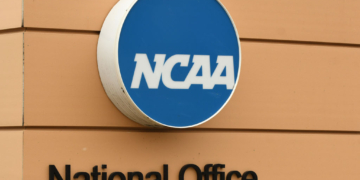The NCAA and its five power conferences made history when they agreed to permit schools to directly pay players.
This move marks the first time in the history of college sports for players to be paid, per ESPN.
The multibillion-dollar agreement will settle three pending federal antitrust cases.
“The NCAA will pay more than $2.7 billion in damages over 10 years to past and current athletes,” according to ESPN. “Sources said the parties also have agreed to a revenue-sharing plan allowing each school to share up to roughly $20 million per year with its athletes.”
NCAA executives noted this is an important step.
“The five autonomy conferences and the NCAA agreeing to settlement terms is an important step in the continuing reform of college sports that will provide benefits to student-athletes and provide clarity in college athletics across all divisions for years to come,” NCAA president Charlie Baker and the five power conference commissioners said Thursday evening.
“This settlement is also a road map for college sports leaders and Congress to ensure this uniquely American institution can continue to provide unmatched opportunity for millions of students. All of Division I made today’s progress possible, and we all have work to do to implement the terms of the agreement as the legal process continues. We look forward to working with our various student-athlete leadership groups to write the next chapter of college sports.”
All Division I athletes from 2016 to the present are eligible to receive compensation as part of the settlement class. However, if the do, athletes cannot sue the NCAA for other potential antitrust violations and must drop their complaints in three open cases — House v. NCAA, Hubbard v. NCAA and Carter v. NCAA.
Judge Claudia Wilken, who is presiding over all three cases, must approve the settlement. That may take several months, and sources said schools likely will begin sharing revenue in fall 2025, per ESPN.
The NCAA board of governors and leaders from the ACC, Big Ten, Big 12, SEC and Pac-12 voted to accept the general terms of the agreement. Notre Dame agreed to the settlement as a member of the ACC.
“The settlement, though undesirable in many respects and promising only temporary stability, is necessary to avoid what would be the bankruptcy of college athletics,” Notre Dame president John I. Jenkins said. “To save the great American institution of college sports, Congress must pass legislation that will preempt the current patchwork of state laws; establish that our athletes are not employees, but students seeking college degrees; and provide protection from further antitrust lawsuits that will allow colleges to make and enforce rules that will protect our student-athletes and help ensure competitive equity among our teams.”
This, however, does not get rid of all pending issues.
“Athletes and their advocates are still fighting to become employees or find other ways to collectively bargain in the future, which could reshape a revenue-sharing agreement,” ESPN reported. “This week’s agreement, though, potentially decreases the NCAA’s exposure to antitrust litigation, which has been the most powerful tool in pushing schools to provide more for athletes.”
As Illinois athletic director Josh Whitman put it, this is just the beginning.
“We recognize that we’re just on the front end of this entire process,” said Whitman, who recently took over as the chairman of the NCAA’s Division I Council. “There’s a lot to be sorted out as we try to really wrap our arms around some of the details that we’re putting in place now.”
Steve Berman, co-lead counsel for the athletes and veteran antirust attorney Jeffrey Kessler, said the agreement feels like a “finish line” but the ultimate end will not happen for awhile.
But Berman is confident the deal will prevail.
“I’m hugely proud,” Berman said. “This is a revolutionary change I never thought would happen when I started this. I’m thrilled for the student-athletes because this will be life-changing for all of them.”


























 Continue with Google
Continue with Google